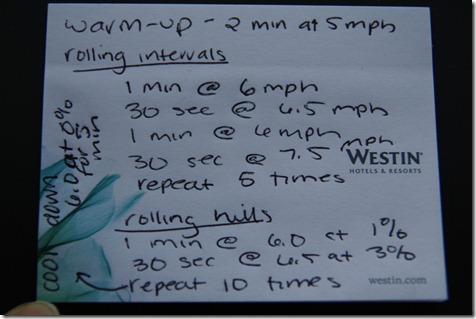Tara wrote: “I’ve been a runner for many years and have completed 8 half marathons. I started running in my early years of university and would always follow a 4-month training program for my races, but by the end of training, I’d get sick of only running. I decided after my last half that I wanted to focus more on strength training and non-running activities. Since then I’ve dabbled in various things like p90x, Jillian Michaels DVDs, using my apartment complex’s small gym… but I’ve never really stuck with anything long-term. I miss the structure of a half marathon training plan, and I’m not getting in all the exercise I want to because I feel somewhat lost and overwhelmed in the dozens of different styles/types of exercises. Some mornings, I set my alarm to get up to work out and then ponder what the heck I even should be doing, end up wasting too much time, and completely miss my workout. I’m feeling a bit discouraged and frustrated as I don’t even think I know where to start.â€

Tara’s problem is pretty common – we’ve all been there, right? You want to workout and kick butt at the gym, but you don’t really know what to do. So you end up half heartedly tooling around on the elliptical for fifteen minutes, lifting a few dumbbells, and wandering out of the gym without really breaking a sweat. You leave feeling kind of defeated but aren’t sure why. The problem isn’t a lack of drive – it’s a lack of focus.

Planning for Success is one of the early concepts discussed in the Healthy Tipping Point book, and I think the philosophy behind it applies well to Tara’s situation. If you’re struggling to get focused, you need a plan. One that is actually written down (on paper, your iPhone, whatever)!
In my eyes, a great plan incorporates the following elements:
-
A list of your short-term and long-term goals. Tara’s short-term goal may be to tone her upper body after years of focusing on running, and her long-term goal may be to find a workout routine she regularly sticks with.
-
A summary of why these goals matter to you (and it’s even better if you can frame your intentions in terms of health as well as appearance – sure, appearance is very motivating, but healthy intentions have staying power).
-
Step-by-step plan to achieve your goals.
-
Clearly defined terms of success.
-
A summary of potential obstacles.
-
An outline of milestone markers (AKA rewards for achieving short- and long-term goals).
It sounds like Tara is getting tripped up by Number 3 – developing a step-by-step plan to achieve her goals. The beauty of training for races or triathlons is that you don’t have to create a plan; training plans do all the work for you! I think this is also why CrossFit is becoming so popular; you arrive at the ‘box’ and there is already an organized W.O.D (Workout of the Day). No wandering around the gym aimlessly. Plans give you focus and direction.

So, what should you do if you lack focus and feel overwhelmed by your workout options, but aren’t interested in doing a race?
-
Commit to one to three types of workouts for a month. For example, for the month of July, Tara could commit to a combination of Jillian Michaels 30 Day Shred (<— here’s my review of the workout) and swimming. Create a workout calendar for the month of July that incorporates these exercises, tape it to your fridge, and follow it as you would a running plan.
-
The next month, you could swap in a different workout, which would help prevent burnout and keep your exercise interesting.
-
Alternatively, you could create a calendar that has you focusing on one different type of workout every week. I interviewed a woman who felt overwhelmed by all the different group exercise classes at her gym; she committed to trying a different class every week for two months. She said she really liked the concept because it gave her enough time to decide if she actually liked the class (sometimes you have to go more than once to really know), she never got bored, and she was in fantastic shape by the end because she constantly challenged her body.
-
Realize you don’t have to stick with one type of workout. It’s perfectly okay to do something different every single day; you’ll still see results.
-
Check out my How to Make Gym Cardio More Bearable post.
-
Find a buddy. A workout buddy is tremendously motivating and can help you focus your efforts.
-
Create a ‘race.’ If you decide to create a personalized training plan, create a deadline – just like a race. Perhaps your goal will be to complete 30 push-ups in two minutes by the end of the two-month period – mentally build up to that challenge and pump up the attempt with a lot of fanfare. Perhaps your race will include banging out Level 3 of the 30 Day Shred and swimming 500 yards, back to back. Or you could make your ‘race’ a triathlon of cardio equipment at the gym – 20 minutes on the treadmill, 20 minutes on the stair climber, and 20 minutes on the elliptical (whew!). Whatever you do, make your deadline extra challenging and fun, and be sure to celebrate your success afterwards.

If you’re not a runner or triathlete and don’t regularly follow a set training plan, how do you stay focused? Do you do the same things every week or do you mix it up with every workout? Any advice for Tara?

Really helpful post as I’m starting to train for my first 10K – I want to do it right and avoid getting injured (like I have in the past).